#$0.34
Photo
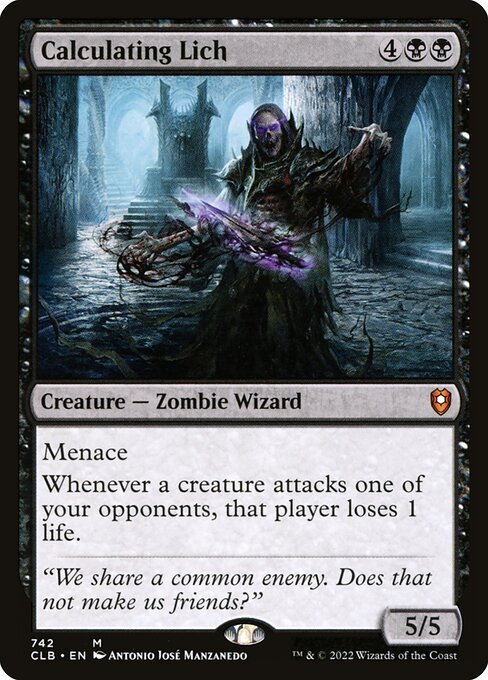
Calculating Lich
"We share a common enemy. Does that not make us friends?"
Artist: Antonio José Manzanedo
TCG Player Link
Scryfall Link
EDHREC Link
#mtg#magic the gathering#tcg#$0.34#antonio josé manzanedo#calculating lich#commander legends: battle for baldur's gate#creature#zombie#wizard
83 notes
·
View notes
Text
only drawing the most important things for my yt vids

#its literally only gonna be in the vid for 0.34 seconds LMAOOOOOOOOOOOOOOOOOOOOO#rumprabbiting#ffxiv#hesperos#rumpart
7 notes
·
View notes
Text
Sana gitme demeyeceğim,
Ama gitme, Lavinia.
Adını gizleyeceğim
Sende bilme Lavinia
Özdemir Asaf
5 notes
·
View notes
Text
i'm doing weird precinct-level election scraping because i'm a freak. and there's a "Comment" field that's mostly blank, or reasonable values. normal stuff
but there's one county where every one of them just says "helllo!" [sic]
i am obsessed
#anyways 766 people (aka 0.34%) voted blank ballots in VA democratic primary#that's significant because there's no “uncommitted” box#you just have to go scan in your ballot and it actually requires a staff person to#(1) come over#(2) confirm your choice#(3) hit a secret button on the back of the machine#so. that's nice
0 notes
Text
Published Feb 14, 2024
Results Also Suggest the Diabetes Risk Persists Across COVID-19 Variants, and That Upfront Vaccination May Help to Reduce Risk of Post-Infection Diabetes
Investigators in the Smidt Heart Institute at Cedars-Sinai have confirmed that people who have had COVID-19 have an increased risk for new-onset diabetes—the most significant contributor to cardiovascular disease.
“Our results validate early findings revealing a risk of developing Type 2 diabetes after a COVID-19 infection and indicate that this risk has, unfortunately, persisted through the Omicron era,” said Alan Kwan, MD, first and corresponding author of the study and a cardiovascular physician in the Smidt Heart Institute at Cedars-Sinai.
The trend, Kwan says, is concerning because most people in the United States will eventually experience a COVID-19 infection. “This research study helps us understand—and better prepare for—the post-COVID-19 era of cardiovascular risk,” Kwan said.
The findings, published today in the journal JAMA Network Open, also suggest that the risk of Type 2 diabetes appears lower in individuals who were already vaccinated against COVID-19 by the time they were infected.
Published Feb 14, 2024
Results
The cohort of 23 709 patients (mean [SD] age, 47.4 [19.3] years) included 12 706 females (54%) and 10 981 males (46%) (22 patients of unknown sex) with 1 or more COVID infection. Rates of new-onset diabetes, hypertension, hyperlipidemia, and benchmark diagnoses occurring in the 90 days after COVID-19 infection were higher than those before infection (Figure). The highest odds postinfection were for diabetes (2.35; 95% CI, 1.94-2.89; P < .001), followed by hypertension (1.54; 95% CI, 1.35-1.76; P < .001), benchmark diagnoses (1.42; 95% CI, 1.25-1.61; P < .001), and hyperlipidemia (1.22; 95% CI, 1.03-1.47; P = .03). In adjusted multivariable models, risk of new-onset diabetes (vs benchmark) diagnosis occurring after vs before COVID-19 infection was significantly elevated (OR, 1.58; 95% CI, 1.24-2.02; P < .001); however, risks of hypertension and hyperlipidemia vs benchmark diagnoses were not (Table). Although the diabetes risk after infection was higher among unvaccinated (OR, 1.78; 95% CI, 1.35-2.37; P < .001) than vaccinated (OR, 1.07; 95% CI, 0.64-1.77; P = .80) patients, the interaction term between vaccination status and diabetes diagnosis was not statistically significant (OR, 0.59; 95% CI, 0.34-1.06; P = .08). There was no evidence of interaction by age, sex, or preexisting cardiovascular risk factors, including hypertension or hyperlipidemia. Age, sex, and timing of index infection regarding the Omicron variant were not associated with an increased risk of a new cardiometabolic diagnosis before or after COVID-19 infection in any model (Table).
#mask up#covid#diabetes#covid isn't over#covid 19#pandemic#covid conscious#covid is airborne#wear a mask#coronavirus#long covid
56 notes
·
View notes
Quote
なんで欧米に必ずと言っていいほどスラムがあるか考えてみるといい
超貧困を少数押し付けるのが欧米、少数だけ極端に低いから貧困率は高くなりにくい
日本は逆で割と保護や還元が低所得者向けになっとるし健康保険とか最たる例
ジニ係数も税還元考慮無しだと0.44と高い方から10番以内だが、税還元考慮有りだと0.34と先進国最下位級
平均年収の10倍以上の人口比なんて日本は欧米の1/2以下しかないし
平均年収と中央値の差も92%とG20で最小なんよ、欧州85~75%、アメリカ67%だからな。
ただし日本のシステムはみんなで均等に貧困を負担して押し付けないから、貧困率が上がってしまう
日本も弱者切り捨ててスラム化させてしまえば貧困率改善するぜ?やっちゃならん事だとは思うが
アメリカの低所得者「貧乏過ぎて電気代も家賃も払えない、食料購入にも苦労している」米国でも広がる格差 | FX2ちゃんねる|投資系まとめ
200 notes
·
View notes
Text
Coming back into the office to find out my coworker who was bored took it upon herself to move my furniture around and rearrange things "to clean the space up". Lads, I'm 0.34 seconds away from committing a crime
36 notes
·
View notes
Photo

Island
Artist: John Avon
TCG Player Link
Scryfall Link
EDHREC Link
45 notes
·
View notes
Text
ATLA Book 1 Character Stats
One thing I have been wondering for a while is how many lines of dialogue each character has in ATLA. I recently figured out an easy way to calculate it, so here are the stats for Book 1.
There are 3490 total lines of dialogue in the season. They are divided up as follows:
Aang 818 lines, 23.44% of total
Katara 633 lines, 18.14% of total
Sokka 610 lines, 17.48% of total
Zuko 174 lines, 4.99% of total (Note: if you include "Young Zuko," this jumps to 182 lines and 5.21%)
Iroh 129 lines, 3.70% of total
Zhao 107 lines, 3.07 of total
Jet 74 lines, 2.12% of total
Yue 51 lines, 1.46% of total
Bumi 45 lines, 1.29% of total
Mechanist 35 lines, 1.00%
Character stats for more obscure characters below:
Jeong Jeong 30 lines, 0.86%
Pakku 29 lines, 0.83%
Teo 29 lines, 0.83%
Bato 28 lines, 0.80%
Wu 28 lines, 0.80%
Zhang leader 28 lines, 0.80%
Shyu 25 lines, 0.72%
Suki 25 lines, 0.72%
Gan Jin leader 23 lines, 0.66%
Haru 23 lines, 0.66%
June 18 lines, 0.52%
Arnook 18 lines, 0.52%
Gyatso 18 lines, 0.52%
Meng 18 lines, 0.52%
Canyon guide 17 lines, 0.49%
Fisherman 16 lines, 0.46%
Warden 16 lines, 0.46%
Roku 15 lines, 0.43%
Chey 14 lines, 0.40%
Pirate captain 14 lines, 0.40%
Herbalist 13 lines 0.37%
Guard 12 lines, 0.34%
Calm man 11 lines, 0.32%
Kay-fon 11 lines, 0.32%
Tyro 11 lines, 0.32%
Earthbender captain 10 lines, 0.29%
Gan Jin tribesman 10 lines, 0.29%
Great Fire Sage 10 lines, 0.29%
Jee 10 lines, 0.29%
Kanna 10 lines, 0.29%
Oh 10 lines, 0.29%
Senlin Village leader 10 lines, 0.29%
Fisherman's wife 9 lines, 0.257879656%
Hahn 9 lines, 0.257879656%
Haru's mother 9 lines, 0.257879656%
Koh 9 lines, 0.257879656%
Captain 8 lines, 0.229226361%
Mother Superior 8 lines, 0.229226361%
Oyaji 8 lines, 0.229226361%
Yagoda 8 lines, 0.229226361%
Young Zuko 8 lines, 0.229226361%
Tashi 7, 0.200573066
Shinu 6, 0.171919771
Storyteller 6, 0.171919771
Air Nomad boy #1 5, 0.143266476
Cabbage merchant 5, 0.143266476
Gate guard 5, 0.143266476
Koko 5, 0.143266476
Lin Yee 5, 0.143266476
Malu 5, 0.143266476
Pipsqueak 5, 0.143266476
Qin 5. 0.143266476
Smellerbee 5, 0.143266476
Air Nomad boy #2 4, 0.114613181
Fire Nation Soldier 4, 0.114613181
Hakoda 4, 0.114613181
Man 4, 0.114613181
Messenger 4, 0.114613181
Ozai 4, 0.114613181
Soldier 4, 0.114613181
Baboon spirit 3, 0.085959885
Little girl 3, 0.085959885
Old man 3, 0.085959885
Omashu captain 3, 0.085959885
Pasang 3, 0.085959885
Southern Water Tribe boy 3, 0.085959885
Tax collector 3, 0.085959885
The Duke 3, 0.085959885
Village girl 3, 0.085959885
Woman 3, 0.085959885
Bujing 2, 0.05730659
Chamberlain 2, 0.05730659
Firebender 2, 0.05730659
Guard captain 2, 0.05730659
Merchant woman 2, 0.05730659
Old Fire Nation civilian 2, 0.05730659
Pirate 2, 0.05730659
Village boy 2, 0.05730659
Village Woman 2, 0.05730659
Aang and Sokka 1, 0.028653295
Aunt Wu 1, 0.028653295
Both 1, 0.028653295
Citizen 1, 0.028653295
Colonists 1, 0.028653295
Crew member 1, 0.028653295
Elder general 1, 0.028653295
Engineer 1, 0.028653295
Eye-patch soldier 1, 0.028653295
Fangirls 1, 0.028653295
Farmer 1, 0.028653295
Fire Nation kids 1, 0.028653295
Fire Sage 1, 0.028653295
Firebenders 1, 0.028653295
Gan Jin man 1, 0.028653295
Girl 1, 0.028653295
Gyatso and Katara 1, 0.028653295
Li 1, 0.028653295
Lieutenant Jee 1, 0.028653295
Man with Red Shoes 1, 0.028653295
Mask dealer 1, 0.028653295
Painter 1, 0.028653295
Ping 1, 0.028653295
Poi 1, 0.028653295
Poi and Ping 1, 0.028653295
Prisoner 1, 0.028653295
Puppet Fire Lord 1, 0.028653295
Scout #1 1, 0.028653295
Scout #2 1, 0.028653295
Scribe 1, 0.028653295
Shop keeper 1, 0.028653295
Shopkeeper 1, 0.028653295
Southern Water Tribe girl 1, 0.028653295
Spectators 1, 0.028653295
Strange Man 1, 0.028653295
Together 1, 0.028653295
Tribal man 1, 0.028653295
Village kids 1, 0.028653295
#ATLA#avatar the last airbender#book 1: water#ATLA stats#ATLA lines#ATLA stat#Avatar#Aang#Katara#Zuko#Sokka#Iroh#Zhao#Jet#Yue#Bumi#the mechanist
22 notes
·
View notes
Text

Thread by @primarycatdad
A McDonalds hamburger costs $2.09 at the register.
McDonalds internal documents show that the raw materials (patty, bun, etc.) cost $0.34. A McDonalds employee makes $11/hr on average with a shift manager making $15/hr. Shifts are 8 people on average. That means McDonalds pays $77 + $15/hr in wages to a shift (total $92). The average McDonalds makes $2.7 million/year in sales. That is $308/hour, or roughly 147 hamburgers every hour at $2.09. Subtracting the wage of the workers ($92) and cost of materials ($49.98), this means there is $166 in surplus value accumulated every hour by the capitalist. If we take the value of the 147 hamburgers and distribute it among the workers who completed them and placed them into circulation, we get $258.02 ($308-$49.98) divided among 8 workers for $32/worker/hour as compared to their $11/hr wages.
The rate of exploitation of the McDonald’s workers is thus, when the raw materials are taken as constant capital and not variable capital, is 32:11, roughly 3:1. This means, that of each hamburger, if 34 cents is raw material and the sale price is $2.09, there is $1.75 attributable to the work of the McDonalds employees in the store. We can divide that value among the 8 workers, and we’d come up with 21 cents per hamburger created by each one. However, let’s look a little more carefully, not merely from the point of view of the McDonald’s capitalist, but from the point of view of the imperialist.
The beef patty in a McDonald’s hamburger weighs 1.6 ounces. According to the corporation, the meat is a combination of chuck ($4/lb), sirloin ($9/lb), and round ($7/lb). The prices of these meats is from the US beef markets. We can take the average of these three prices: $6.50/lb. For the amount contained in a hamburger (1.6 ounces), this comes to roughly .65 cents ($6.50/16 = .40). As you can see, this is more than the entire value of the raw materials in the McDonald’s hamburger. Even if they receive a twenty-five per-cent discount for bulk operations, that’s still 49 cents per hamburger.
One of the top countries supplying beef to McDonalds is Brazil, which shouldn’t be a surprise: the Brazilian ranching industry supplies a huge amount of worldwide beef, and grows it on land assarted from the Amazon. A Brazilian livestock handler makes 16 reals/hr, which is $3.21 USD. Brazilian beef costs a mere $1.76 and $2/lb. We can see why. The price of Brazilian beef is so much lower because the Brazilian worker’s wage is so much lower. Why is that? Imperialism.
The labor market of Brazil is artificially depressed by fascists like Bolsonaro, who are put into power by US interests to keep prices low. US monopoly capital also destroys the quality of life in imperialized countries because this is how the socially necessary labor time is determined for reproducing the labor force.
If the Brazilian beef costs 34 cents for 1.6 ounces while the reproduction cost of the Brazilian ranch hand is $3.21 an hour, then we may establish a ratio - roughly $3/hr to 30 cents or $1/hr to 10 cents. If the ranch hand made $11/hour just as the metropolitan workers do, this would be an increase of 3 and a half times, increasing the Brazilian beef cost to $1.19 for 1.6 ounces.
If we wished to maintain the price equilibrium by which the hamburger is sold at $2.09, this would require an equalization of wages between the metropolitan worker and the peripheral worker. That is to say, because the hamburger is worth $1.75 in labor ($1.75+$0.34=$2.09) from the metropolitan worker, we must equalize the $1.75 in metropolitan labor with the $0.34 in peripheral labor.
If we were to divide these into two equal parts, that is, $1.04 worth of peripheral labor crystallized in the meat and $1.04 worth of labor in the metropole for the finishing of the meat into a final product, that is a change of $0.71 in favor of the peripheral worker. For each hamburger made, the metropolitan worker is paid 3x the wage of the peripheral worker. The metropolitan worker cooking the burger on the grill, assembling the worker, dealing with angry customers, and selling the burger; the ranch hand is enduring near-slave conditions on the Brazilian plain.
The metropolitan worker is directly paid 3 times more for their labor, the hamburger’s cost is depressed for all metropolitan workers, the metropolitan capitalists (the monopoly capitalists) provide other social safety benefits to keep the class consciousness of the metropolitan workers from developing, and they also concentrate the high-waged, final finishing work for products and the management positions within the metropole. These are the wages of imperialism. Lots of quote tweets etc. demanding I account for credit, interest payments, advertising, salaries for HR and executives, franchising fees, rent, machinery, etc.
I didn't factor in any of the standard constant capital valuations for a reason: it obscures the point, which is the law of unequal development and the imperialist forced underdevelopment of the periphery. The pay for the entire cavalcade of non-productive or marginally productive executives, HR reps, advertising, etc., etc., all comes out of the 11 hamburgers sold after the first 7. So do the salaries of the CEOs.
Rent actually isn't a factor for a McDonalds because the corporation owns the ground. The franchisee pays the corporate office rent, but the corporate office pays no one. These costs are all marginal - as are the electricity and water costs and the degradation of the grill, etc. The grill itself costs around $3,000 but can make an untold number of hamburgers, imparting to the hamburger a mere fraction of a fraction of a cent. The typical annual mcdonalds power bill is $40,000. That works out to $4.5/hour or 3 cents per burger at the average rate of 147 burgers per hour.
The cost of upper management is mostly faux frais which can be eliminated, or non-productive labor which is parasitic, etc. There is still PLENTY of value to cover the necessary work at higher levels. And obviously there are things other than burgers made at a McDonalds - each product has a different individual rate of exploitation for the workers (for example, the soda is hugely exploitative and mostly mark-up).
Important, however, is that most of the profit is not from MARKUP (charging more than a thing is worth) but from THEFT (stealing and refusing to compensate the legitimate labor of the worker).
#mcdonalds#imperialism#wage#i disagree with the point of 'theft' as has already been quite exhaustively detailed by marx#but otherwise broadly good demonstration of the basic mechanisms of exploitation i'd say
603 notes
·
View notes
Note
I am here to cause you more pain.
So technically, Amane currently has an overall guilty percentage. (51.66% guilty - 51.32% innocent = 0.34% guilty :(((((( ) Therefore, I am asking what flavor you would add to LCSYS, and how would it differ from Muu, if- *runs away*
*cracks knuckles* *cries*
Okay, so if Amane is one of the final guilties, I have two major directions I’d take Es’ remorse. The first and most prominent are their similarities to one another. Es would reflect on how they really are just about the same age. Both had limited knowledge of the world when arriving in Milgram. Both saw killing the guilty as their duty. I’d make a lot of physical comparisons: when Es sees themselves in the interrogation room mirror they might be struck with the fact that they look as small as her. Maybe their hair has grown out a bit and looks like hers. They’re hit with the thought that the only thing separating themself from Amane really was the clothes they were wearing -- so why did Es alone have the right to choose her fate?
The other, even more evil route that I’d take would be comparing Es to Amane’s mother. I don’t know exactly how executions will go, but something tells me Milgram is going to put us through hell hearing the prisoners’ last words. Es would reflect on Amane’s apologies and pleading, and realize that her mother heard those exact same cries, and ignored them in the exact same way. I’d tie in some Purch March lyrics about Amane’s desperate “I’m sorry” once again going unheard. It wouldn’t be painting Es as a villain per se, but the comparison would communicate that Amane was a victim in her life way more often than she was a perpetrator. That no matter how hard she tried to be a good girl, there would always be someone in front of her ready to punish her for it.
#milgram#lights camera sing your sins#:((((#my goal is to cause es and the reader maximum pain so that the following section is even more of a relief#though idk -- maybe when it ends and weve all suffered though the finale i may not have it in me to cause any more pain... ;--;#but this better be all hypothetical 👁️👁️#because youre all voting her inno t3 right 👁️👁️#right 👁️👁️#oof ill have to look at the numbers again... i want to work out the percentages for everyone going into t3#like which ratio is needed to save/condemn each of them if it really is a combination of numbers#tw child abuse
21 notes
·
View notes
Note
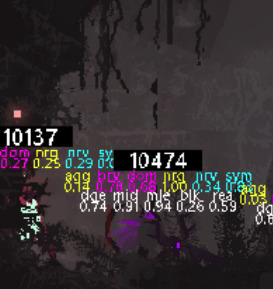
SCAVENGER I.D #10474

Hex codes
Eyes: #2596be
Head/hand: #1d0a26
Neck/mid arm: #1d0a26
Body: #352735
Belly: #40363f
Spines: #9d25d9
Personality traits
Aggression: 0.14
Bravery: 0.70
Dominance: 0.68
Energy: 1.00
Nervousness: 0.34
Sympathy: 0.83
Other traits
Dodge: 0.74
Mid: 0.91
Melee: 0.94
Block: 0.26
Reaction time: 0.59



#submisson#scavenger#rw scavenger#every scavenger ever#rainworld#rain world game#rw downpour#rain world#rain world downpour#rain world slugcat
61 notes
·
View notes
Photo

Road traffic death rate in the US vs Europe
by u/flyingcatwithhorns
Source:
https://www.iihs.org/topics/fatality-statistics/detail/state-by-state
https://transport.ec.europa.eu/news/preliminary-2021-eu-road-safety-statistics-2022-03-28_en
https://www.who.int/data/gho/data/themes/topics/topic-details/GHO/road-traffic-mortality
Edit: Found the data for a few countries for fatality rate per 100 million vehicle kilometres travelled (higher = worse)
Iceland 0.21
Norway 0.21
Sweden 0.26
United Kingdom 0.34
Germany 0.37
Switzerland 0.39
Slovenia 0.40
Ireland 0.41
OECD median 0.41
Australia 0.44
Finland 0.46
Canada 0.47
France 0.50
New Zealand 0.66
United States 0.83
Czech Republic 0.99
https://www.bitre.gov.au/sites/default/files/documents/international_comparisons_2020.pdf, page 20/34
192 notes
·
View notes
Text
via “Some disasters caused by numerical errors”:
On February 25, 1991, during the Gulf War, an American Patriot Missile battery in Dharan, Saudi Arabia, failed to track and intercept an incoming Iraqi Scud missile. The Scud struck an American Army barracks, killing 28 soldiers and injuring around 100 other people. A report of the General Accounting office, GAO/IMTEC-92-26, entitled Patriot Missile Defense: Software Problem Led to System Failure at Dhahran, Saudi Arabia reported on the cause of the failure. It turns out that the cause was an inaccurate calculation of the time since boot due to computer arithmetic errors. Specifically, the time in tenths of second as measured by the system's internal clock was multiplied by 1/10 to produce the time in seconds. This calculation was performed using a 24 bit fixed point register. In particular, the value 1/10, which has a non-terminating binary expansion, was chopped at 24 bits after the radix point. The small chopping error, when multiplied by the large number giving the time in tenths of a second, led to a significant error. Indeed, the Patriot battery had been up around 100 hours, and an easy calculation shows that the resulting time error due to the magnified chopping error was about 0.34 seconds.
(The number 1/10 equals
1/2⁴+1/2⁵+1/2⁸+1/2⁹+1/2¹²+1/2¹³+....
In other words, the binary expansion of 1/10 is
0.0001100110011001100110011001100....
Now the 24 bit register in the Patriot stored instead 0.00011001100110011001100 introducing an error of 0.0000000000000000000000011001100... binary, or about 0.000000095 decimal. Multiplying by the number of tenths of a second in 100 hours gives 0.000000095×100×60×60×10=0.34.)
A Scud travels at about 1,676 meters per second, and so travels more than half a kilometer in this time. This was far enough that the incoming Scud was outside the “range gate” that the Patriot tracked. Ironically, the fact that the bad time calculation had been improved in some parts of the code, but not all, contributed to the problem, since it meant that the inaccuracies did not cancel, as discussed here.
The following paragraph is excerpted from the GAO report.
The range gate's prediction of where the Scud will next appear is a function of the Scud's known velocity and the time of the last radar detection. Velocity is a real number that can be expressed as a whole number and a decimal (e.g., 3750.2563...miles per hour). Time is kept continuously by the system's internal clock in tenths of seconds but is expressed as an integer or whole number (e.g., 32, 33, 34...). The longer the system has been running, the larger the number representing time. To predict where the Scud will next appear, both time and velocity must be expressed as real numbers. Because of the way the Patriot computer performs its calculations and the fact that its registers are only 24 bits long, the conversion of time from an integer to a real number cannot be any more precise than 24 bits. This conversion results in a loss of precision causing a less accurate time calculation. The effect of this inaccuracy on the range gate's calculation is directly proportional to the target's velocity and the length of the the system has been running. Consequently, performing the conversion after the Patriot has been running continuously for extended periods causes the range gate to shift away from the center of the target, making it less likely that the target, in this case a Scud, will be successfully intercepted.
[x]
The March 13 issue of Science carried an article claiming, on the basis of a report from the General Accounting Office (GAO), that a “minute mathematical error … allowed an Iraqi Scud missile to slip
through Patriot missile defenses a year ago and hit U.S. Army barracks in Dhahran, Saudi Arabia, killing 28 servicemen.” The article continues with a readable account of what happened.
The article says that the computer doing the tracking calculations had an internal clock whose values were slightly truncated when converted to floating-point arithmetic. The errors were proportional to the time on the clock: 0.0275 seconds after eight hours and 0.3433 seconds after 100 hours. A calculation shows each of these relative errors to be both very nearly 2⁻²⁰, which is approximately 0.0001%.
The GAO report contains some additional information. The internal clock kept time as an integer value in units of tenths of a second, and the computer's registers were only 24 bits long. This and the consistency in the time lags suggested that the error was caused by a fixed-point 24-bit representation of 0.1 in base 2. The base 2 representation of 0.1 is nonterminating; for the first 23 binary digits after the binary point, the value is 0.1 × (1 - 2⁻²⁰). The use of 0.1 × (1 - 2⁻²⁰) in obtaining a floating-point value of time in seconds would cause all times to be reduced by 0.0001%.
This does not really explain the tracking errors, however, because the tracking of a missile should depend not on the absolute clock-time but rather on the time that elapsed between two different radar pulses. And because of the consistency of the errors, this time difference should be in error by only 0.0001%, a truly insignificant amount.
Further inquiries cleared up the mystery. It turns out that the hypothesis concerning the truncated binary representation of 0.1 was essentially correct. A 24-bit representation of 0.1 was used to multiply the clock-time, yielding a result in a pair of 24-bit registers. This was transformed into a 48-bit floating-point number. The software used had been written in assembly language 20 years ago. When Patriot systems were brought
into the Gulf conflict, the software was modified (several times) to cope with the high speed of ballistic missiles, for which the system was not originally designed.
At least one of these software modifications was the introduction of a subroutine for converting clock-time more accurately into floating-point. This calculation was needed in about half a dozen places in the program, but the call to the subroutine was not inserted at every point where it was needed. Hence, with a
less accurate truncated time of one radar pulse being subtracted from a more accurate time of another radar pulse, the error no longer cancelled.
In the case of the Dhahran Scud, the clock had run up a time of 100 hours, so the calculated elapsed time was too long by 2⁻²⁰ × 100 hours = 0.3433 seconds, during which time a Scud would be expected to travel more than half a kilometer.
The roundoff error, of course, is not the only problem that has been identified: serious doubts have been expressed about the ability of Patriot missiles to hit Scuds.
Robert Skeel is a professor of computer science at the University of Illinois at Urbana-Champaign.
From SIAM News, July 1992, Volume 25, Number 4, page 11
[x]
lmao
45 notes
·
View notes
Text
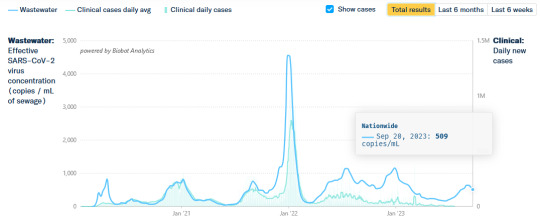
woo, yeah, look at that vaccine go. we're down to 500 copies/ml in wastewater -- a number i would characterize as being in the middle of a wave and capable of going up again, but still

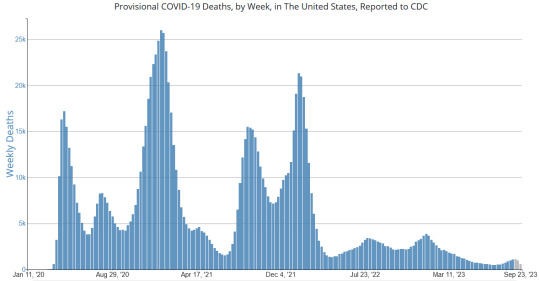
hospitalizations are, tentatively, also going down, and deaths remain at what can only be described as the lowest point so far
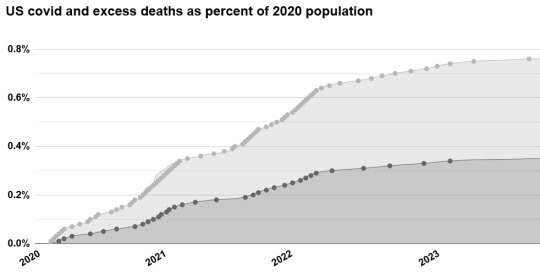
that said, we did just hit 0.76% population loss in the us (if you count excess deaths, which are in the 1.8-2.2x range, likely higher at the beginning or when hospitals were at capacity and likely lower now)
it took 20 weeks to gain another hundredth of a percent, longer than it's taken at any other time... counting only deaths directly attributed to covid, it's been 30 weeks since we hit 0.34% and it will probably take another 3 weeks to hit 0.35%
this is another way to demonstrate just how much the rate of death from covid has changed. we're probably at about 58,000 deaths for the year so far, on par to become maybe the 8th leading cause of death, after diabetes (100k) and before liver and kidney disease (55k). this, too, is largely attributable to vaccination rate eventually reaching about 70%, as it has been consistently shown in statistical analysis that vaccination reduces risk of serious outcomes, etc and so on. but it has not stopped
20 notes
·
View notes
